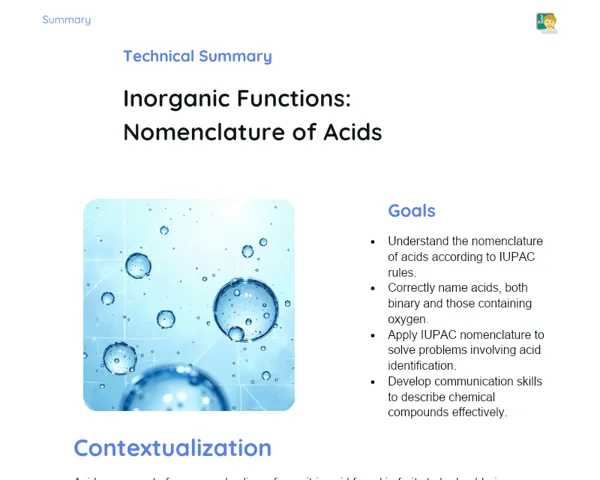Goals
1. Accurately name phenols using IUPAC nomenclature.
2. Differentiate the nomenclature of phenols from that of other organic compounds.
3. Identify the essential structural traits of phenols.
4. Recognize the significance of phenols in both industry and laboratory settings.
Contextualization
Phenols are organic compounds that find application across numerous fields and industries. From making medications to producing plastics, grasping the structure and naming conventions of phenols is crucial for practical use. For instance, phenols are integral to the creation of disinfectants and antiseptics, such as the well-known phenol in hospitals. In industrial contexts, phenols are key ingredients in the making of plastics like polycarbonate and Bakelite, which are vital for manufacturing household products and electronic devices. Additionally, many medicines, including aspirin, are derived from phenolic compounds, showing their critical role in pharmaceuticals.
Subject Relevance
To Remember!
IUPAC Nomenclature of Phenols
The IUPAC nomenclature (International Union of Pure and Applied Chemistry) provides a systematic framework for the naming of chemical compounds. This is particularly important for phenols to ensure these molecules are correctly identified. Phenols are compounds with a hydroxyl group (-OH) attached to an aromatic ring. Correctly naming these compounds involves identifying the positions of the hydroxyl group and other substituents on the aromatic ring.
-
Phenols originate from benzene and contain one or more hydroxyl groups (-OH).
-
In IUPAC nomenclature, the position of the hydroxyl group on the aromatic ring is considered.
-
All additional substituents on the aromatic ring should be accurately numbered and named.
Identifying the Structure of Phenols
Identifying the structure of phenols requires recognizing the hydroxyl group that is bonded directly to the aromatic ring. Unlike alcohols, where the hydroxyl group is connected to a saturated carbon, in phenols, it’s attached to a carbon in the benzene ring. This structural difference is key in distinguishing phenols from other organic compounds and in applying IUPAC nomenclature correctly.
-
Phenols feature an aromatic ring with a hydroxyl group directly attached.
-
The structure of phenols is distinct from alcohols, where the -OH is linked to a saturated carbon.
-
The position of the hydroxyl group and other substituents on the aromatic ring is vital for precise identification.
Difference Between Phenols and Other Organic Compounds
Phenols can be distinguished from other organic compounds, such as alcohols and ethers, by their unique structure and chemical characteristics. While alcohols feature a hydroxyl group linked to a saturated carbon, phenols have the hydroxyl group attached to a sp2 carbon within the aromatic ring. This disparity grants phenols distinct properties, including greater acidity compared to alcohols and the capability to form complexes with metals.
-
Phenols have a hydroxyl group linked to an aromatic ring, while alcohols have the -OH connected to a saturated carbon.
-
Phenols exhibit higher acidity than alcohols, a feature attributable to the stabilization of the phenoxide anion.
-
Phenols can form stable metal complexes, which are used in various industrial applications.
Practical Applications
-
Production of disinfectants and antiseptics: Phenol and its derivatives are commonly utilized in cleaning and disinfectant products due to their antimicrobial properties.
-
Synthesis of plastics: Phenols serve as precursors in the manufacture of plastics like polycarbonate and Bakelite, which are crucial for household appliances and electronic components.
-
Development of medications: Numerous medications, such as aspirin, are derived from phenolic compounds, underscoring the vital role of phenols in the pharmaceutical sector.
Key Terms
-
Phenol: An organic compound characterized by a hydroxyl group directly linked to a benzene ring.
-
IUPAC Nomenclature: A systematic method for naming chemical compounds established by the International Union of Pure and Applied Chemistry.
-
Hydroxyl Group (-OH): A functional group comprised of one oxygen atom and one hydrogen atom, common in alcohols and phenols.
-
Aromatic Ring: A cyclic structure with alternating double bonds, prevalent in compounds like benzene and phenols.
Questions for Reflections
-
What impact does precise nomenclature of phenols have on the safety and efficacy of drug manufacturing?
-
How does the structure of phenols shape their chemical properties and industrial uses?
-
Why is it important to differentiate phenols from other organic compounds, such as alcohols and ethers, within the realm of organic and industrial chemistry?
Hands-On Challenge: Identification and Naming of Phenols
To reinforce your understanding of phenol nomenclature, we will engage in a practical challenge centred on constructing molecular models and accurately identifying phenols using IUPAC nomenclature.
Instructions
-
Form groups of 3 to 4 members.
-
Utilize molecular modeling kits to create the following phenols: phenol (C6H5OH), 2-methylphenol (C7H8O), and 4-nitrophenol (C6H4N2O3).
-
Once the models are made, accurately name each phenol using IUPAC nomenclature.
-
Present your models to the class, highlighting the structure and nomenclature of each compound.
-
Compose a brief report (1-2 paragraphs) on the significance of phenols in industry and how proper nomenclature can influence the production of pharmaceuticals and other chemicals.



